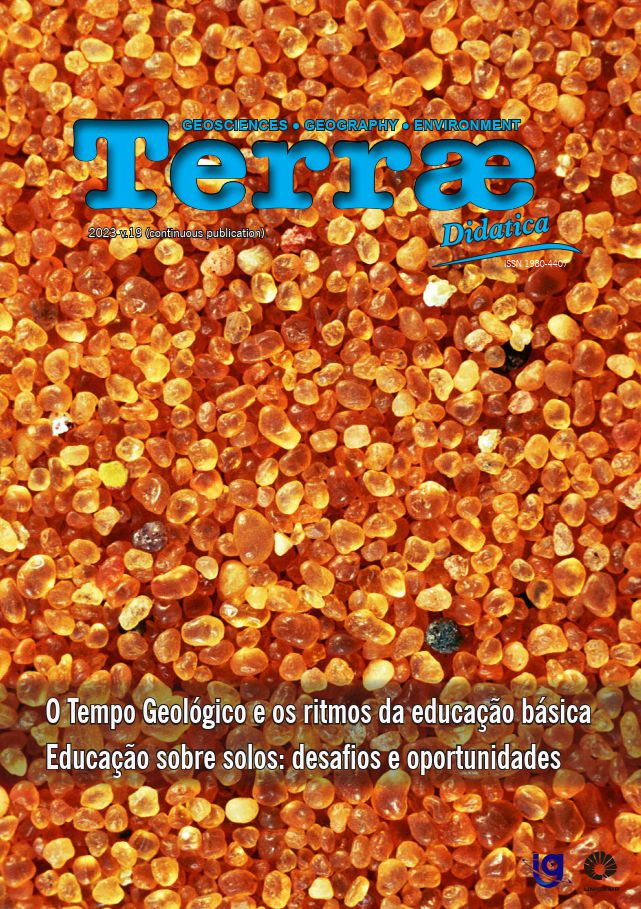Abstract
Introduction. The natural diversity of planet Earth is formed by the interrelationship between biodiversity and geodiversity. However, it is remarkable the greater attention given to the first than the second, both in society and at school. Objective and Methodology. We sought from the qualitative research to find out how the approach to geodiversity is carried out in the regional normative documents of the state of Paraná reformulated in the process of implementing the BNCC, in the curricular component of geography. Results. It was found that in relation to the BNCC, the regional documents, more detailed, represent a certain advance, however, they still end up presenting largely the same shortcomings as the national: fragmented and without connections with other themes. Conclusion. The incipient relational approach of the contents combined with the rigid adoption of the didactic material were the main obstacles of the regional curriculum to the theme of geodiversity and may result in an incomplete view of the environment.
References
Bacci, D. C. (2015). Ensino de Geociências no contexto escolar. Múltiplas relações com a educação ambiental. In: Bacci, D. C. (Org.). (2015). Geociências e educação ambiental. Curitiba: Ponto Vital Editora. p.129-151.
Brasil. Ministério da Educação. (2018). Base Nacional Comum Curricular: Educação é a base. Brasília, DF. 595p. URL: http://basenacionalcomum.mec.gov.br/images/BNCC_EI_EF_110518_versaofinal_site.pdf. Acesso 14.05.2023.
Brasil. Ministério da Educação. (2023). Histórico da BNCC. URL: Histórico (mec.gov.br). Acesso 14.05.2023.
Brilha, J. B. R. (2005). Patrimônio Geológico e Geoconservação: a conservação da natureza na sua vertente geológica. Braga: Palimage. 190p.
Callai, H. C. (1995).O estudo do município ou a geografia nas séries iniciais. Boletim Gaúcho de Geografia, 20, 31-34. URL: https://seer.ufrgs.br/bgg/article/view/38030/24532. Acesso 14.05.2023.
Carneiro, C. D. R., Toledo, M. C. M. de, & Almeida, F.F.M. de. (2004). Dez motivos para a inclusão de temas de Geologia na Educação Básica. Revista Brasileira de Geociências, 34(4), 553-560. doi: 10.25249/0375-7536.2004344553560.
Costella, R. Z., & Rego, N. (2011). Em que momento um aluno aprende geografia. In: Rego, N., Castrogiovanni, A. C., & Kaercher, N. A. (Orgs.). (2011). Geografia: Práticas Pedagógicas para o Ensino Médio. Vol. 2, Porto Alegre: Penso. p. 104-118.
Cunha, L. F. F. (2018). A geografia escolar e as temáticas físico-naturais na BNCC: desafios a prática docente e à formação de professores. Itinerarius reflectiones, 14(2), 1-18. doi: 10.5216/rir.v14i2.51587.
Gray, M. (2004). Geodiversity: Valuing and Conserving Abiotic Nature. Londres: John Wiley & Sons. 434p.
Guimarães, E. M. (2004). A contribuição da Geologia na construção de um padrão de referência do mundo físico na educação básica. Revista Brasileira de Geociências, 34(1), 87-94.
Kozel, S. (1998). Ensinar geografia no terceiro milênio: Como? Por quê? RA’E GA – Revista do Departamento de Geografia UFPR, 2,141-152.
Liccardo, A., & Guimarães, G. B. (Org.) (2014). Geodiversidade na educação. Ponta Grossa: Estúdio Texto. 136p.
Moreira, J. C. (2011). Geoturismo e interpretação ambiental. Ponta Grossa: Editora UEPG. 157p.
Morin, E. (2000). Os sete saberes necessários à educação do futuro. 2 ed. São Paulo: Cortez; Brasília: UNESCO. 118p.
Paraná. (Estado). Secretaria da Educação e do Esporte. (2021a). Currículo da rede estadual paranaense. Curitiba. 69p. URL: https://www.educacao.pr.gov.br/sites/default/arquivos_restritos/files/documento/2021-05/crep_geografia_2021_anosfinais.pdf. Acesso 14.05.2023.
Paraná. (Estado). Secretaria da Educação e do Esporte. (2021b). Referencial curricular para o ensino médio do Paraná. Curitiba. 1062p. URL: https://www.educacao.pr.gov.br/sites/default/arquivos_restritos/files/documento/2021-08/referencial_curricular_novoem_11082021.pdf. Acesso 14.05.2023.
Piekarz, G. (2011). Geoturismo no Karst. Curitiba: Mineropar. 121p.
Pinheiro, I., & Lopes, C. S. (2021). A geografia na base nacional comum curricular (BNCC): percursos e perspectivas. Geo UERJ, 39, 1-23. doi: 10.12957/geouerj.2021.45521.
Ponciano, L. C., Castro, A. R., Machado, D. M. C., Fonseca, V. M. M., & Kunzler, J. (2011). Patrimônio Geológico-Paleontológico in situ e ex situ: definições, vantagens, desvantagens e estratégias de conservação. In: Carvalho, I. S., Srivastava, N. K., Strochschoen Jr., O., & Lana, C. C. (Eds.). (2011). Paleontologia: Cenários de Vida. Rio de Janeiro: Interciência, v. 4., p. 853-870.
Sharples, C. (1993). A Methodology for the Identification of Significant Landforms and Geological Sites for Geoconservation Purposes. Tasmania: The Forestry Commission. 33p.
Silva, J. M., & Mendes, E. P. P. (2013). Abordagem qualitativa e geografia: pesquisa documental, entrevista e observação. In: Marafon, G. J., Ramires, J. C. L., Ribeiro, M. A., & Pessôa, V. L. S. (Comps.). (2013). Pesquisa qualitativa em geografia: reflexões teórico-conceituais e aplicadas. Rio de Janeiro: Ed. UERJ. p. 207-221. doi: 10.7476/9788575114438.0013.
Silva, J. V. M., & Moura-Fé, M. M. (2020). A geodiversidade na geografia escolar: reflexões teóricas e a importância da geoeducação. Geomae, 11(1), 143-157.
Silvone, B. R., & Tsukamoto, R. Y. (2006). Nos passos da aprendizagem: o trabalho de campo como método de ensino de geografia. In: Antonello, I. T., Moura, I. D. P., & Tsukamoto, R. Y. (Orgs.). (2006). Múltiplas geografias: ensino-pesquisa-reflexão. Vol. III. Londrina: Edições Humanidades. p. 71-105.

This work is licensed under a Creative Commons Attribution 4.0 International License.
Copyright (c) 2023 Geovani Krüger, Gilson Burigo Guimarães


